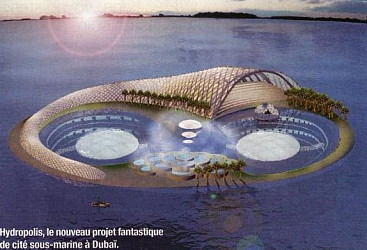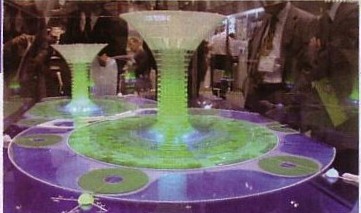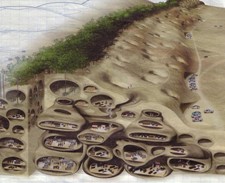 hibis, the reality, nothing else.
hibis, the reality, nothing else.
|
hibis  Curiosity. Curiosity.
|
|
activités domestiques'>
 French French
this page, Architec - Futuristic, imaginary.
Futuristic ? Here are the aspirations of some originals who may end up being right.
A rotating house (nice to follow the sun, or to protect itself.) Houses widely open on the nature - it is trendy - or modular, with panels and furnitures movable, rotating and tilting, in short, retractable;
Places to live "3D" , at several shifted levels (everything is off-beat at home), why not, glass floors to see below (or above), pools that start inside, and so many other breathtaking things, and made for.
- A great original live in an inflatable house , at La Ferté Allais (one thousandth bar of pressure only).
When he opens the
door, it deflates! to reduce the space it deflates. He he watches photos or pictures on a giant screen while listening very Hi-Fi music.
In bad weather he projects sun! The house is also very technical. I do not know anything about furniture.
If necessary, he could pump for add a wing for a reception. It's the future, he says, convinced.
- A visionary architect assumes that it will make little sense to go down a 400-story tower and go further up into another 800.
So he is considering the city or more vaguely architectural space, like giant towers connected together by ways at different levels. Comments hibis
It's somehow as a Luc Besson's film, the fifth element, where we see the cars "flyin " get out of the walls of very tall buildings and move to
different levels. Developing his idea, he evokes towers-cities of very large size. This appropriation of the space in height would allow, he says, to house the world's population in a limited number of
giant constructions.
Comment hibis : I guess, with spaces for sports, gardens and why not fields, woods and forests ? The problem of natural lighting
would become obviously crucial because with the supreme heights, this monstrous gruyère will only be dark and drafts.
it's not for tomorrow. But already now, housing surfaces and even their height shrinkle, and with the growth of the world's population, something must be done to make life even more difficult.
We can also dream of a new global cataclysm that would put everything.. flat.
Artificial islands.
Sand Castles. In the Persian Gulf, which is also shallow, artificial islands have been created, and that continues. Luxury hotels, dream villas, apartment buildings
prestige, nothing is too beautiful.
Islands in the shape of palms, symbolic representation of the countries of the world.
Who says better ? hurry up, it's off! It was ; now, I don't know.
Floating islands.
Floating island projects are flourishing because of the legal uncertainty in international waters.
Alsthom - but he is not the only one, has proposed a floating island moving at a very slow speed, including a small harbor.
|
They hope to create new states or kingdoms ,
which is not so utopian as it seems. Living in a secluded oceanic place - for the moment - brings security and freedom, key assets for
these future tax havens voting their own laws . But that does not seem be so easy to achieve because nowdays, only a boat-hotel for billionaires is sailing, and not independently.
Scientific platforms.
The Russians, who do not have rightly located bases (*) for launching their rockets, have considered building a floating base; this project is now abandoned in favor of the Franco-European base of Kourou (Guyana), which now hosts the rocket Soyuz.
(*) at the equator, the most "launching" place, which saves energy.
2019. US are back : first tests to compete with the Russians (international space station)
(*)at the equator, see Physics (hibis).
|
hotels under water.
Actually real (2010), with foot on dry land, is the Poseidon Undersea Resort, (Bahamas). A French-American group, US Submarine raised 40 million dollars (33 EUR million) for its construction.
 The price of the 50 m2capsul -15m, is already set at nearly 4,000 dollars per night for two. (2014)
The price of the 50 m2capsul -15m, is already set at nearly 4,000 dollars per night for two. (2014)
In Dubai, a major project would be on the water: the Hydropolis, underwater city with research laboratory, hotel 220
suites -20m, with views of submerged gardens, three restaurants, including "The Nautilus" ;. Cost not estimated, but openness announced for end 2006! it was in 2004, nothong in 2010, is it 2016 ? (assembled in Germany).
|
|

|
Living on an artificial island in the shape of a water lily, here is the Japanese project of the company Shimizu. Platforms 3km in diameter float on the Pacific Ocean.
In the center, towers 1000m high (we will see the pirates from afar). Cultures in trays in towers, farms, wind turbines, recycling, sliding walls against storms (?), Dream (or nightmare).
Under development, planned for 2025. (Sciences et Avenir, March 2011). These islands will float freely .. It is not expected to control their movement?
|
Do Japanese people think about the future of their own people? probably not, although their country is too small and uncertain. Do the Japanese think of their own fate on their big
island too small and uncertain? The cost may well reduce ambition to nothing. The most surprising is, at this stage, that the islets float freely, according to the winds and the currents, to go crashing one day against a real hard coast or to meet a boat? or be swept away and engulfed by the Gulf Sream.
Seen like that, it is very very beautiful. And very very artificial too, like the creations of Singapore.
|
Desert, trees barrier.
The Great Green Wall sprouted in the spirit of Burkina Faso President Thomas Sankara in the 1980s; it resurrected in 2005 thanks to Nigeria's President Olusegun Obasanjo and was finally approved in December 2006 by the African Union.
In February 2011, the project was formally endorsed at the Bonn International Summit in Germany.
The Global Environment Facility (GEF) has so far allocated $ 115 million in funding.
There has been a start of tree planting, but I do not know anything about now state.
|
 Desert, inhabited dunes.
Desert, inhabited dunes.
We can then better understand such a project, which is based on the hope of stopping the progress of the desert along a line Senegal - Djibouti, by planting trees on a strip of 15 kilometers wide and nearly 8,000 kilometers crossing eleven countries .
Swedish architecture student Magnus Larsson proposes to concretize this band by solidifying the sand dunes to create a habitable wall that would block the advance of the desert.
|
Desrt, solidification of the dunes .
In an effort to stabilize soil in seismic regions, researchers at the University of California are experimenting with injecting a bacterium into the soil into a calcium-rich alkaline mixture.
The method involves stimulating bacteria to excrete large amounts of calcium carbonate, which cements the sand.
Even if the results are convincing, admits Larsson, the implementation will be difficult to finance. "The cost would be insane" (Popular Science New York)
|
The best architects? Termites !! (New Scientist London). Fruit of the mechanisms of evolution, social insects provide interesting leads
to build sustainable cities of the future .. hibis: Fruits of the mechanisms of evolution, men also knew not to build anyhow; of the
farms are still there to attest, as well as huts of dried mud and straw or oriental buildings. Now they are cooling concrete.
At the heart of the African savannah are towers of a city built entirely of natural biodegradable materials.
Its inhabitants live and work in air-conditioned and humid areas, without consuming a single watt of electricity. The water comes from deep wells.
With its curved walls and elegant arches, it also has a certain beauty.
It's not a human city, of course it's a termite mound. & quot; We humans apply absurd architectural ideas without incurring the sanction of natural selection ", observe the architect Juhani Pallasmaa, from the University of Technology.
|
As we become aware of climate change
 and resource depletion, we seem to have a lot to learn from these insects that know how to cool and ventilate.
and resource depletion, we seem to have a lot to learn from these insects that know how to cool and ventilate.
Hot Country Project (would it be better or easier than cold countries?): Basics
: Conduct the condensation of the water contained in the air, store it and purify it. That in sufficient quantity the current consumption and the shower; the latter recycled for toilets and agriculture.
A composting system generates biogas for the kitchen. For most of the year, natural air flows through the windows of the house are sufficient to cool it.
|
During the hottest months, a fan draws outside air into an underground chamber, where the temperature "would be & quot; between 10 and 15'C throughout the year. Cool air
It is then conveyed into the basement, then upwards into the house through holes in the ground.
As fresh air warms, it rises and escapes through an inner courtyard of 19 square meters, in which a narrow vertical cavity forms a wind tower (diagram opposite).
24 mobile photovoltaic panels follow the course of the sun and, thanks to lenses, the solar radiation is multiplied by 2000;
they & quot; would produce & quot; the 80 kilowatt hours of electricity consumed daily by the household. Also installed on the roof, wind turbines vertical axis Darrieus type
& Quot; generate & quot; 40 additional kilowatt hours. (Popular Science, New York)
|
Almost all of these technologies are currently exploited on a small scale.
The non-profit organization "Fog Quest" uses fog to supply water to Ethiopian villages.
- A long time ago, seems it to me, dew nets were installed on the slopes of the Andes.
- In Zimbabwe, the Eastgate Center uses huge perforated fireplace-shaped structures to pump surrounding air into the interior.
- In Orange County, California, the Groundwater Replenishment System turns wastewater into drinking water.
(Popular Science, New York).
Finally, animals are precusors ! what learns us a desert insect is edifying : it condenses moisture at dawn on its shell, then directs the drops of water to his mouth ! (English animal report, February 14 (TV A2)
In 2008, for the first time, more than half of the Earth's population was urbanized, and this trend poses considerable challenges.
By 2030, an estimated 5 billion people will live in cities - up from around 3.3 billion in 2010. And these cities are likely to be densely populated.
Part of the population will certainly live in new buildings, but Stéphane Malka has another idea: insert buildings within existing buildings .
HOW ? he suggests completing the empty space of the central part of the Arch of Defense. This concept could be applied to any building.
hibis
MONEY and large spaces for a very few, crippling discomfort for others.. Meanwhile, in France, any municipality with more than 5,000 inhabitants must provide land for "Roms travelers", which will occupy an undisturbed space.
|
Densification. This is the key word of architects, developers and leaders, who will not personally be embarrassed.
We should regroup all this beautiful people in their own creations so that they experiment them themselves !!
While some offer themselves 500 m² or more, the average offered surfaces evolve to 50 m² or less, for a small family with ceiling heights reduced - in France to 2m 40, thank to the government - as the population size grows. Only prices keep increasing. Common people who once built their own cities - which we visit now, are totally ignored.
An architect plans for Los Angeles, the sprawling city that would span much of the French coast d'Azur, a construction of 580 meters high, consisting of several towers, which could accommodate 800,000 people, a density 26 times higher than present. (Popular Science New York).
|
Containers. What should be reserved for the poor, who can no longer lodge, will be the lot of everyone.
 In Amsterdam, the container village of Keetwonen, very densely populated, already hosts students in a thousand studios.
In Amsterdam, the container village of Keetwonen, very densely populated, already hosts students in a thousand studios.
Presented like here in the middle of nature, it would be almost a pleasant second home .. I doubt that the urban pilings are as flattering.
Besides, when properly insulated for temperature and noise (scrap metal), and sufficient openings, the cost is not so cheap.
And openings in a stack, there will be few.
|

 Colors - construction, arts Colors - construction, arts
| 



 and resource depletion, we seem to have a lot to learn from these insects that know how to cool and ventilate.
and resource depletion, we seem to have a lot to learn from these insects that know how to cool and ventilate.
 In Amsterdam, the container village of Keetwonen, very densely populated, already hosts students in a thousand studios.
In Amsterdam, the container village of Keetwonen, very densely populated, already hosts students in a thousand studios.